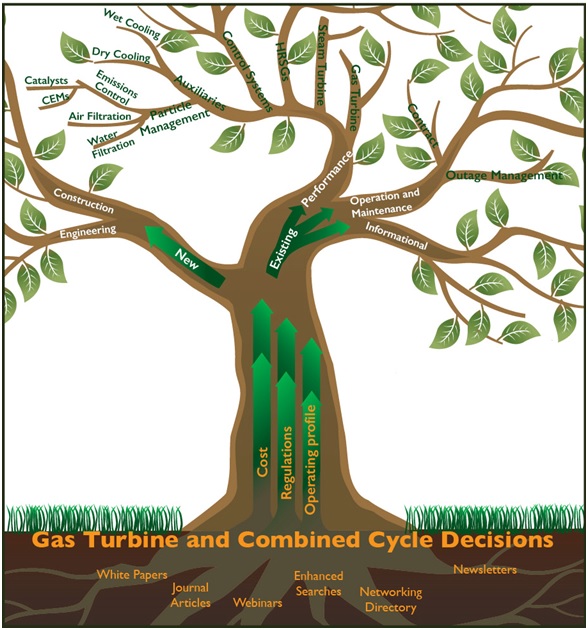NEWS RELEASE JUNE 2015
Operators Are Challenged To Keep Up With Latest Gas Turbine Combined Cycle Technology
A number of new products, services and processes combined with changing regulations are making it difficult to make the right decisions relative to the purchase of new gas turbine and combined cycle components. Operation and maintenance decisions are also being impacted by new options and new demands. McIlvaine is offering an organized decisions program to ease the effort and help operators make the best choices.

The basic decision is whether to start with a simple cycle or combined cycle design. One option is to add the steam cycle later. In any case, the fuel efficiency is low without the combined cycle operation. If the plant is going to be situated at the site of an old coal-fired power plant, the owner must decide whether to use the existing boiler feedwater treatment and wastewater systems. There is even the possibility to use the existing boiler for steam generation. Fuel selection is very important. Which will be the primary fuel and will there be a liquid backup fuel which can be stored on site? A recent additional option is LNG which can be delivered by what is called the virtual pipeline (truck). China is planning massive use of coal-derived gas.
The emission control approach differs greatly between simple and combined cycle operations. In the simple cycle system, the selective catalytic system for NOx reduction is subjected to high temperatures. Use of an expensive high temperature catalyst is one option. An alternative is to bleed in ambient air and operate at lower temperatures.
The method by which NH3 is delivered to the catalyst system differs. Urea to ammonia processes eliminate safety hazards during transport. Aqueous ammonia has low safety risks but is more expensive than anhydrous ammonia.
Cooling options include wet, hybrid and dry cooling. There are cost implications as well as environmental. The energy required for dry cooling with air cooled condensers is high. Another concern is capacity in hot weather. One the other hand, dry cooling is an answer to water scarcity or difficulty in obtaining a water permit.
The water and wastewater issues can be avoided even with wet cooling. Many plants are opting to use treated municipal wastewater. They can also install Zero Liquid Discharge (ZLD) systems. Assuming that the treated municipal wastewater would otherwise have been sent to a receiving stream, the GTCC plant can claim to reduce area water pollution rather than increase it.
It is desirable to take a holistic view when selecting components. The question of pulse jet cleanable intake filters vs. static filters should factor in the valve system used to clean the pulsed filters. A better design pulse cleaning system may be just as important as a better filter medium.
There are pump design considerations based on the fast cycling needs. The drive decisions are also impacted. Pumps for once-through cooling can be fitted with variable speed drives to make flow adjustments. One reason to adjust flow is to minimize damage to aquatic life. There are substantial analyses of this phenomenon.
Electric, hydraulic and pneumatic actuator each have advantages and disadvantages. The best option varies with the service. There are a number of innovations in HRSG design to adapt to the fast cycling needs. Just to keep up with new developments with this technology is a challenge.
There are many operational challenges. Should you repair or replace service valves? An alternative to buying the lowest first cost valve and then replacing it frequently is to buy the best valve and repair rather than replace it. Operational problems with rapid cycling GTCC systems include Flow Accelerated Corrosion (FAC). Stellite delamination of valves is another problem created by rapid cycling.
Rapid progress is being made with gas turbine combined cycle power plants. In order to stay abreast, consider Gas Turbine and Combined Cycle Decisions.



